Citroen C3 PICASSO 2014 1.G Owner's Manual
Manufacturer: CITROEN, Model Year: 2014, Model line: C3 PICASSO, Model: Citroen C3 PICASSO 2014 1.GPages: 292, PDF Size: 9.23 MB
Page 181 of 292
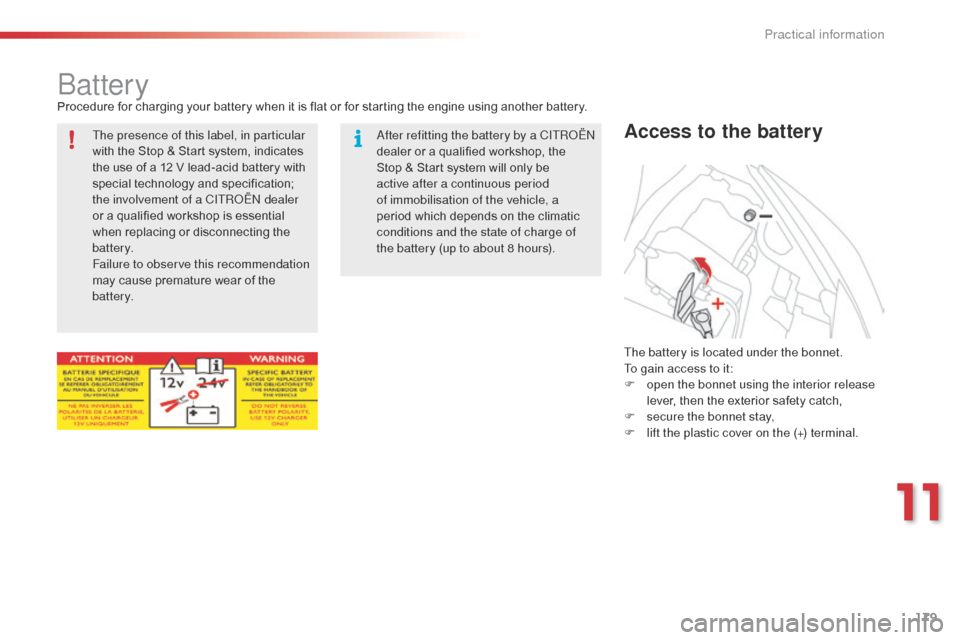
179
C3Picasso_en_Chap11_informations-pratiques_ed01-2014
batteryProcedure for charging your battery when it is flat or for starting the engine using another battery.
Access to the battery
The battery is located under the bonnet.
To gain access to it:
F
o
pen the bonnet using the interior release
lever, then the exterior safety catch,
F
s
ecure the bonnet stay,
F
l
ift the plastic cover on the (+) terminal.
The presence of this label, in particular
with the Stop & Start system, indicates
the use of a 12 V lead-acid battery with
special technology and specification;
the involvement of a CITR
oËn
dealer
or a qualified workshop is essential
when replacing or disconnecting the
battery.
Failure to observe this recommendation
may cause premature wear of the
battery.
af
ter refitting the battery by a CITR
oËn
dealer or a qualified workshop, the
Stop
& Start system will only be
active after a continuous period
of immobilisation of the vehicle, a
period which depends on the climatic
conditions and the state of charge of
the battery (up to about 8 hours).
11
Practical information
Page 182 of 292

180
C3Picasso_en_Chap11_informations-pratiques_ed01-2014
First check that the slave battery has a
nominal voltage of 12 V and a capacity
at least equal to that of the discharged
battery.
do n
ot try to start the engine by
connecting a battery charger.
Do not disconnect the (+) terminal when
the engine is running.
F
C
onnect the red cable to the positive
terminal (+) of the flat battery A , then to the
positive terminal (+) of the slave battery B.
F
C
onnect one end of the green or black
cable to the negative terminal (-) of the
slave battery B (or earth point on the other
vehicle).
F
C
onnect the other end of the green or
black cable to the negative terminal C (or
the engine mounting) of the broken-down
vehicle.
F
S
tart the engine of the other vehicle and
allow it to run for a few minutes.
Starting using another
battery
When the battery on your vehicle is discharged,
the engine can be started using a slave battery
(external or on another vehicle) and jump leads.
F
O
perate the starter of the broken-down
vehicle and let the engine run.
I
f the engine does not start immediately,
switch off the ignition and wait a few
moments before trying again.
F
W
ait until the engine returns to idle, then
disconnect the jump leads in reverse order. Some functions are not available if the
battery is not sufficiently charged.
Practical information
Page 183 of 292

181
C3Picasso_en_Chap11_informations-pratiques_ed01-2014
Charging the battery using
a battery charger
F Follow the instructions for use provided by the manufacturer of the charger.
do n
ot disconnect the battery to charge it. Protect your eyes and face before
handling the battery.
al
l operations on the battery must be
carried out in a well ventilated area
away from naked flames and sources
of sparks, so as to avoid the risk of
explosion and fire.
Do not try to charge a frozen battery;
the battery must first be thawed out to
avoid the risk of explosion. If the battery
has been frozen, before charging have
it checked by a CITR
oËn
dealer or a
qualified workshop who will check that
the internal components have not been
damaged and the casing is not cracked,
which could cause a leak of toxic and
corrosive acid.
do n
ot reverse the polarity and use only
a 12 V charger.
Do not disconnect the terminals while
the engine is running.
Do not charge the batteries without
disconnecting the terminals first.
Wash your hands after wards.
ba
tteries contain harmful substances such
as sulphuric acid and lead. They must be
disposed of in accordance with regulations
and must not, in any circumstances, be
discarded with household waste.
Take used remote control batteries and
vehicle batteries to a special collection
point.
11
Practical information
Page 184 of 292
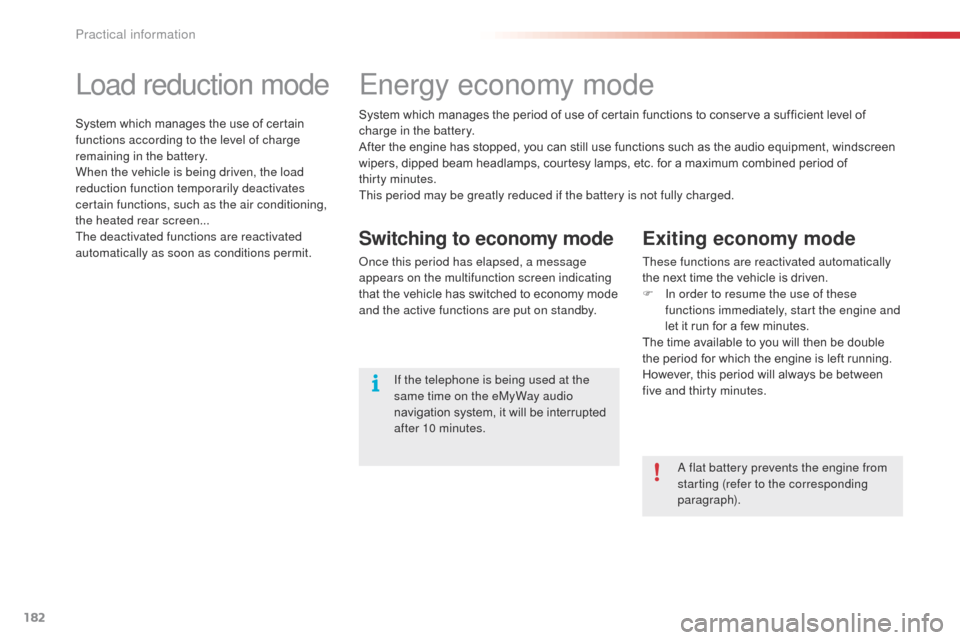
182
C3Picasso_en_Chap11_informations-pratiques_ed01-2014
Load reduction mode
System which manages the use of certain
functions according to the level of charge
remaining in the battery.
When the vehicle is being driven, the load
reduction function temporarily deactivates
certain functions, such as the air conditioning,
the heated rear screen...
The deactivated functions are reactivated
automatically as soon as conditions permit.
Energy economy mode
Exiting economy mode
These functions are reactivated automatically
the next time the vehicle is driven.
F
I
n order to resume the use of these
functions immediately, start the engine and
let it run for a few minutes.
The time available to you will then be double
the period for which the engine is left running.
However, this period will always be between
five and thirty minutes.
Switching to economy mode
once this period has elapsed, a message
appears on the multifunction screen indicating
that the vehicle has switched to economy mode
and the active functions are put on standby.
a
flat battery prevents the engine from
starting (refer to the corresponding
paragraph).
If the telephone is being used at the
same time on the eMyWay audio
navigation system, it will be interrupted
after 10 minutes.
System which manages the period of use of certain functions to conserve a sufficient level of
charge in the battery.
After the engine has stopped, you can still use functions such as the audio equipment,
windscreen
wipers, dipped beam headlamps, courtesy lamps, etc. for a maximum combined period of
thirty
minutes.
This period may be greatly reduced if the battery is not fully charged.
Practical information
Page 185 of 292
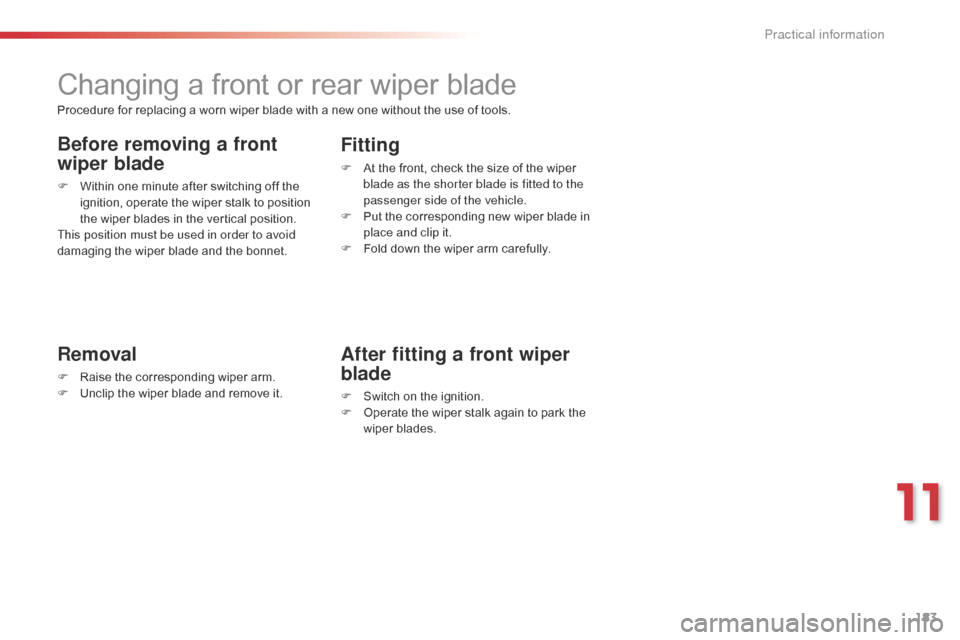
183
C3Picasso_en_Chap11_informations-pratiques_ed01-2014
Changing a front or rear wiper blade
Removal
F Raise the corresponding wiper arm.
F U nclip the wiper blade and remove it.
Fitting
F At the front, check the size of the wiper blade as the shorter blade is fitted to the
passenger side of the vehicle.
F
P
ut the corresponding new wiper blade in
place and clip it.
F
F
old down the wiper arm carefully.
Before removing a front
wiper blade
F Within one minute after switching off the ignition, operate the wiper stalk to position
the wiper blades in the vertical position.
This position must be used in order to avoid
damaging the wiper blade and the bonnet.
After fitting a front wiper
blade
F Switch on the ignition.
F O perate the wiper stalk again to park the
wiper blades.
Procedure for replacing a worn wiper blade with a new one without the use of tools.
11
Practical information
Page 186 of 292

184
C3Picasso_en_Chap11_informations-pratiques_ed01-2014
Towing the vehicle
Access to the tools
The towing eye is installed under the boot floor.
To gain access to it:
F
o
pen the boot,
F
r
emove the adjustable boot floor,
F
l
ift up the boot carpet,
F
r
emove the towing eye from the tool holder.
Procedure for having your vehicle towed or for towing another vehicle using a removable towing eye.
General recommendations
observe the legislation in force in your country.
Ensure that the weight of the towing vehicle is higher than that of the towed vehicle.
The driver must remain at the wheel of the towed vehicle and must have a valid driving licence.
When towing a vehicle with all four wheels on the ground, always use an approved towing
arm; rope and straps are prohibited.
The towing vehicle must move off gently.
When towing a vehicle with the engine off, there is no longer any power assistance for
braking or steering.
In the following cases, you must always call on a professional recovery service:
-
v
ehicle broken down on a motor way or fast road,
-
f
our-wheel drive vehicle,
-
w
hen it is not possible to put the gearbox into neutral, unlock the steering, or release
the parking brake,
-
t
owing with only two wheels on the ground,
-
w
here there is no approved towing arm available...
Practical information
Page 187 of 292

185
C3Picasso_en_Chap11_informations-pratiques_ed01-2014
Towing your vehicle
F on the front bumper, passenger's side,
remove the protective access cover located
alongside the front fog lamp, using the flat
end of the towing eye. F
on t he rear bumper, unclip the cover by
pressing at the bottom.
F
S
crew the towing eye in fully.
F
I
nstall the towing bar.
F
S
witch on the hazard warning lamps on the
towed vehicle.
Towing another vehicle
Failure to observe this special condition
could result in damage to certain
braking components and the absence
of braking assistance the next time the
engine is started.
When removing the protective access
cover, take care to avoid damaging the
paintwork with the towing eye. F
S
crew the towing eye in fully.
F
I
nstall the towing bar.
F
S
witch on the hazard warning lamps on the
towed vehicle.
F
P
lace the gear lever in neutral.
11
Practical information
Page 188 of 292
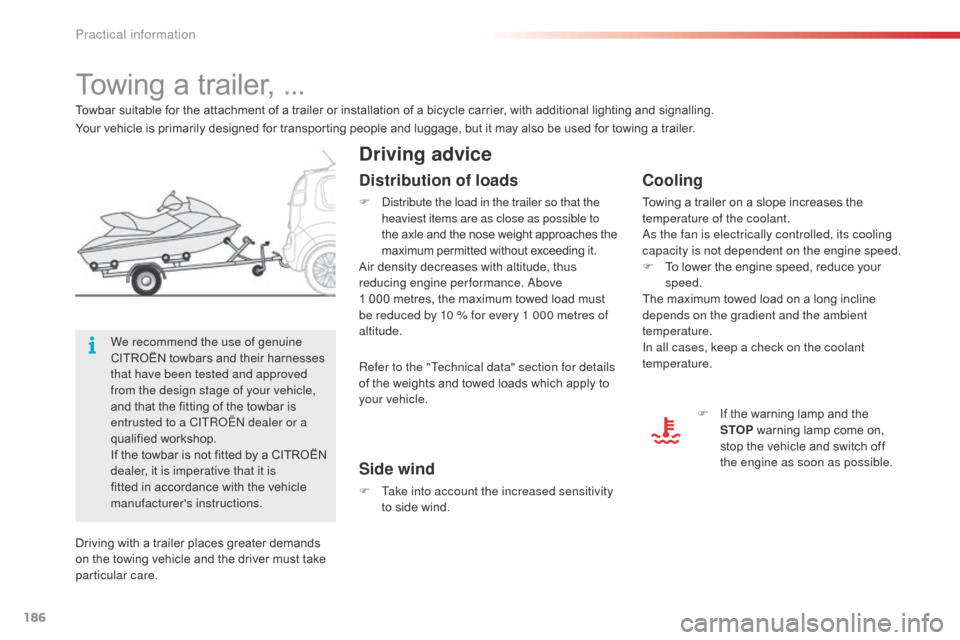
186
C3Picasso_en_Chap11_informations-pratiques_ed01-2014
Towing a trailer, ...
Driving advice
Cooling
Towing a trailer on a slope increases the
temperature of the coolant.
as t
he fan is electrically controlled, its cooling
capacity is not dependent on the engine speed.
F
T
o lower the engine speed, reduce your
speed.
The maximum towed load on a long incline
depends on the gradient and the ambient
temperature.
In all cases, keep a check on the coolant
temperature.
Side wind
F Take into account the increased sensitivity to side wind. F
I
f the warning lamp and the
STOP warning lamp come on,
stop the vehicle and switch off
the engine as soon as possible.
Towbar suitable for the attachment of a trailer or installation of a bicycle carrier, with additional lighting and signalling.
Distribution of loads
F distribute the load in the trailer so that the
heaviest items are as close as possible to
the axle and the nose weight approaches the
maximum permitted without exceeding it.
Air density decreases with altitude, thus
reducing engine performance.
a
b
ove
1
000 metres, the maximum towed load must
be reduced by 10
% for every 1 000 metres of
altitude.
We recommend the use of genuine
CITROËN towbars and their harnesses
that have been tested and approved
from the design stage of your vehicle,
and that the fitting of the towbar is
entrusted to a CITR
oËn
dealer or a
qualified workshop.
If the towbar is not fitted by a CITROËN
dealer, it is imperative that it is
fitted in accordance with the vehicle
manufacturer's instructions.
Driving with a trailer places greater demands
on the towing vehicle and the driver must take
particular care. Your vehicle is primarily designed for transporting people and luggage, but it may also be used for towing a trailer.
Refer to the "Technical data" section for details
of the weights and towed loads which apply to
your vehicle.
Practical information
Page 189 of 292
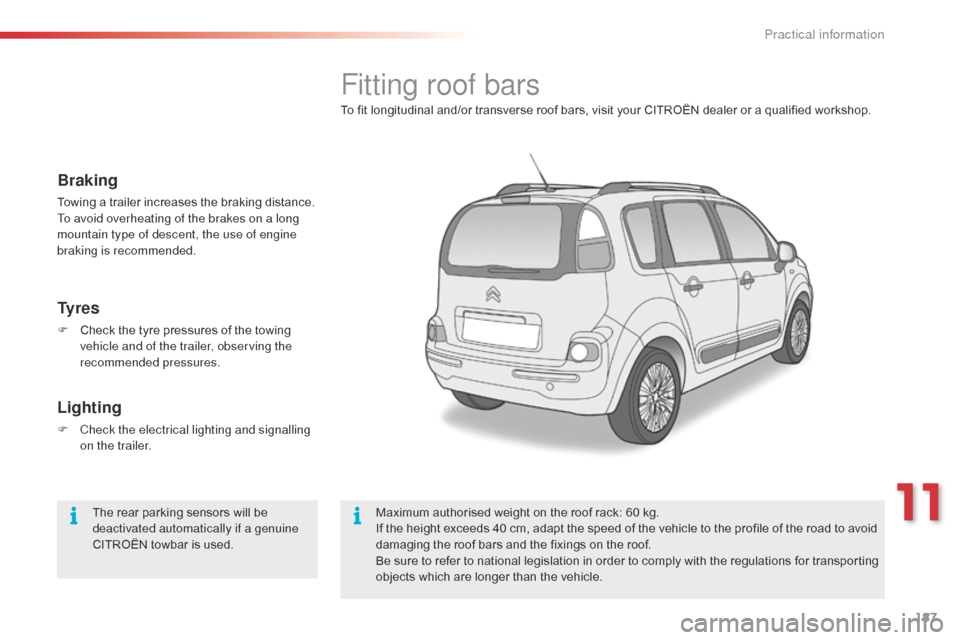
187
C3Picasso_en_Chap11_informations-pratiques_ed01-2014
Fitting roof bars
To fit longitudinal and/or transverse roof bars, visit your CITROËN dealer or a qualified workshop.Maximum authorised weight on the roof rack: 60 kg.
If the height exceeds 40 cm, adapt the speed of the vehicle to the profile of the road to avoid
damaging the roof bars and the fixings on the roof.
Be sure to refer to national legislation in order to comply with the regulations for transporting
objects which are longer than the vehicle.
Braking
Towing a trailer increases the braking distance.
To avoid overheating of the brakes on a long
mountain type of descent, the use of engine
braking is recommended.
Ty r e s
F Check the tyre pressures of the towing vehicle and of the trailer, observing the
recommended pressures.
Lighting
F Check the electrical lighting and signalling on the trailer.
The rear parking sensors will be
deactivated automatically if a genuine
CITROËN towbar is used.
11
Practical information
Page 190 of 292
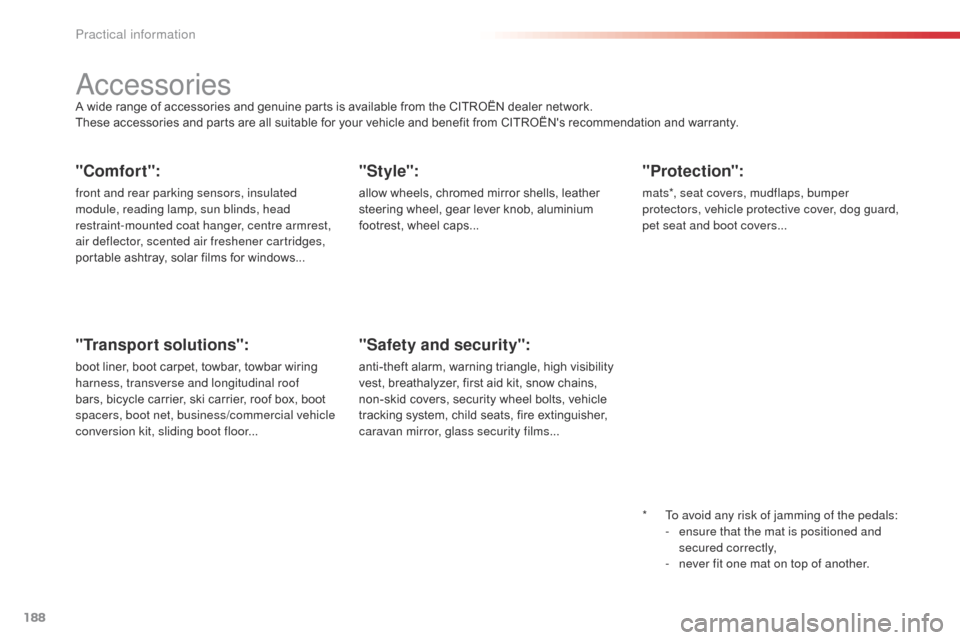
188
C3Picasso_en_Chap11_informations-pratiques_ed01-2014
"Comfort":
front and rear parking sensors, insulated
module, reading lamp, sun blinds, head
restraint-mounted coat hanger, centre armrest,
air deflector, scented air freshener cartridges,
portable ashtray, solar films for windows...
"Protection":
mats*, seat covers, mudflaps, bumper
protectors, vehicle protective cover, dog guard,
pet seat and boot covers...
"Transport solutions":
boot liner, boot carpet, towbar, towbar wiring
harness, transverse and longitudinal roof
bars, bicycle carrier, ski carrier, roof box, boot
spacers, boot net, business/commercial vehicle
conversion kit, sliding boot floor...
"Safety and security":
anti-theft alarm, warning triangle, high visibility
vest, breathalyzer, first aid kit, snow chains,
non-skid covers, security wheel bolts, vehicle
tracking system, child seats, fire extinguisher,
caravan mirror, glass security films...
"Style":
allow wheels, chromed mirror shells, leather
steering wheel, gear lever knob, aluminium
footrest, wheel caps...
accessoriesA wide range of accessories and genuine parts is available from the CITROËN dealer network.
These accessories and parts are all suitable for your vehicle and benefit from CITROËN's recommendation and warranty.*
T
o avoid any risk of jamming of the pedals:
-
e
nsure that the mat is positioned and
secured correctly,
-
n
ever fit one mat on top of another.
Practical information